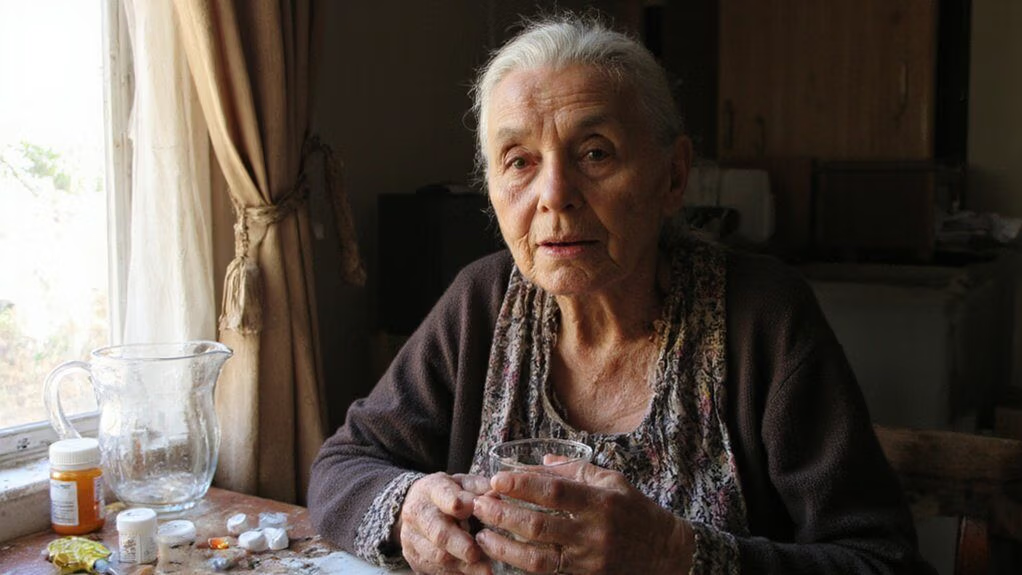Older adults dehydrate faster because they have lower fluid reserves, blunted thirst, and more chronic meds and illnesses. You should watch for acute confusion, dizziness on standing, reduced urine volume and dark color, dry mucous membranes, weak or rapid pulse, and sudden functional decline. Here’s what to watch for and what to do next.
Why Older Adults Are More Susceptible to Dehydration

Because aging alters both physiology and circumstance, older adults face higher dehydration risk: total body water and muscle mass decline, thirst perception blunts, and the kidneys lose concentrating ability and sodium–water homeostasis, reducing fluid reserves and impairing compensatory responses. You should recognize that polypharmacy — especially diuretics, laxatives, anticholinergics, and ACE inhibitors — increases renal fluid loss, alters hemodynamics, or impairs intake. Chronic illnesses like heart failure, diabetes, and CKD change fluid distribution and narrow safety margins. Mobility limitations, dental problems, dysphagia, and cognitive impairment reduce access to and intake of fluids. Cutaneous evaporative capacity declines, and febrile or gastrointestinal illnesses can precipitate deficits. As a clinician or caregiver, you’ll prioritize routine fluid-status assessment, medication review, and tailored rehydration strategies that balance cardiac and renal risks.
Thirst Cues and How They Change With Age

Recognize that altered thirst signaling is a major contributor to dehydration risk in older adults: aging blunts hypothalamic osmoreceptor sensitivity and reduces baroreceptor-mediated thirst responses, so plasma osmolality rises further before a person feels thirsty. You may not sense thirst until deficit is advanced; medications (diuretics, anticholinergics), reduced renal concentrating ability, and comorbidities (heart failure, diabetes) magnify this. Relying on thirst alone is thus inadequate. Use objective cues: monitor urine color and volume, track intake, weigh daily when indicated, and set scheduled drinking intervals. Employ low-burden innovations—flavored water, cups with markings, smart reminders or hydration-tracking apps—to normalize regular intake. Discuss individualized targets with clinicians, adjust for activity and environment, and reassess routinely to prevent silent dehydration. Report decreased intake to your care team promptly.
Confusion, Dizziness, and Cognitive Changes to Watch for

When older adults become even mildly dehydrated, you’re likely to see acute confusion, new-onset dizziness or lightheadedness, and subtle changes in attention, processing speed, or mood that can mimic infection or dementia; these cognitive and balance symptoms reflect decreased intravascular volume, altered cerebral perfusion, and electrolyte shifts that disproportionately affect the frail brain. Assess for acute onset, fluctuating course, orthostatic symptoms, and new sleep or mood changes; these guide rapid rehydration and targeted tests.
- Onset: sudden confusion or disorientation.
- Dizziness: orthostatic or positional lightheadedness.
- Cognition: slowed processing, attention lapses.
- Mood/behavior: agitation, apathy, or withdrawal.
Act quickly: verify orthostatics, review medications, check basic electrolytes and consider brief cognitive testing to monitor response to rehydration. Document changes and communicate with caregivers promptly.
Weakness, Fatigue, and Sudden Declines in Mobility
Although often subtle, sudden weakness, marked fatigue, or a new decline in walking and transfers are common and reversible signs of dehydration in older adults. You may notice reduced endurance, slower gait, or difficulty rising from a chair without systemic illness. Decreased intravascular volume impairs muscle perfusion and aerobic metabolism, producing proximal weakness and exercise intolerance; these changes often improve with measured rehydration. Assess baseline mobility, orthostatic physiologic signs, and medication-related contributors such as diuretics or anticholinergics. Use objective measures—timed up-and-go, 30-second chair stand—and monitor response to fluid resuscitation over 24–48 hours. Collaborate with clinicians to personalize fluid plans, avoiding overload in cardiac or renal disease. Early recognition preserves independence and reduces fall risk, aligning innovative, evidence-based care with patient goals and dignity safely.
Urine Output, Color, and Bathroom Patterns That Signal Risk
How much urine someone makes, its color, and changes in bathroom habits give clear, early clues to dehydration risk in older adults. You should monitor frequency, volume, and color trends; sudden drops in output, very dark urine, or concentrated odor suggest decreased fluid intake or fluid losses. Track patterns against baseline and report deviations to clinicians promptly. Use objective measures—diary, timed voiding, smart sensors—when available. You’ll work with your care team, set alert thresholds, and intervene early to prevent hospitalizations, reduce kidney injury, and improve outcomes safely rapidly.
- Low frequency: fewer than four voids/24h or marked reduction from baseline.
- Dark yellow/amber urine persisting after fluids.
- Small-volume voids or straining.
- New nocturia or incontinence changes signaling fluid redistribution or renal stress.
Dry Mouth, Cracked Lips, and Changes in Swallowing
You may notice dry mouth and cracked lips from reduced fluid intake, anticholinergic or diuretic medications, mouth breathing, or systemic conditions such as diabetes. These causes increase risk of mucosal breakdown and oral infection, and you should watch for trouble chewing, coughing or throat clearing with meals, food sticking, or unexplained weight loss as signs of swallowing difficulty. Report these symptoms to your clinician so they can assess hydration, review medications, perform a swallowing screen, and plan appropriate interventions.
Dry Mouth Causes
Because saliva production falls with age and many commonly prescribed drugs have anticholinergic or drying effects, older adults often develop xerostomia that leads to cracked lips and altered swallowing. You should know common causes so you can address them proactively.
- Polypharmacy (anticholinergics, diuretics)
- Systemic disease (diabetes, Sjögren’s)
- Head/neck radiation therapy
- Behavioral factors (mouth breathing, smoking, low fluid intake)
Evaluate medication lists, glycemic control, and radiation history. Consider objective testing (sialometry) and dental or ENT consultation. Interventions include medication optimization, saliva substitutes or secretagogues, humidification, and targeted behavioral change. Monitor oral mucosa and hydration status, and iteratively adjust treatments based on clinical data to preserve comfort and function. You and your clinician can co-design innovative, evidence-based plans that prioritize quality of life and safety overall.
Swallowing Difficulty Signs
If an older adult develops persistent dry mouth, cracked lips, or subtle changes in chewing and swallowing, you’re seeing early indicators that the oral and pharyngeal phases of swallowing may be compromised.
| Sign | Clinical implication |
|---|---|
| Dry mouth | Reduced bolus formation |
| Cracked lips | Poor oral seal and intake pain |
| Altered swallow | Increased aspiration risk |
You should assess saliva volume, lip integrity, chewing efficiency, and cough during meals; these signs correlate with aspiration risk and impaired hydration. Intervene with targeted oral care, texture modification, salivary stimulants, and multidisciplinary rehabilitation. Monitor weight, intake, and mealtime fatigue using objective scales. Technology-assisted swallowing exercises and smart hydration cues can augment conventional therapy. Engage the person and caregivers in goal-setting and shared decision making, and document outcomes to guide treatment.
Skin Turgor, Elasticity, and Slow Wound Healing
Although skin turgor and elasticity visibly decline with age, they reflect structural and physiological changes rather than dehydration alone: collagen and elastin fibers break down, subcutaneous fat thins, and dermal hydration falls, which together make the skin more fragile and slow wound repair.
- Interpret pinch tests cautiously, noting baseline age-related recoil.
- Assess wound size, depth, exudate, and infection signs.
- Optimize hydration, protein, vitamin C, and zinc intake.
- Apply topical barrier protection and consider advanced wound technologies.
You should interpret clinical findings in context, document changes, and coordinate multidisciplinary care. You should engage caregivers, use telemedicine, and institute daily checks to monitor healing closely. Report worsening wounds promptly and adjust interventions based on objective measures and patient goals. Stay proactive daily.
Rapid Heart Rate, Low Blood Pressure, and Dizziness on Standing
When you stand, gravity shifts blood to your legs and abdomen, which can drop cardiac preload and blood pressure and trigger a compensatory rise in heart rate; in older adults this cascade is amplified by reduced baroreflex sensitivity, polypharmacy, and intravascular volume depletion. You may feel lightheaded, see dimming vision, or experience palpitations as compensatory tachycardia attempts to preserve cerebral perfusion. Measure orthostatic parameters: supine, immediate standing, and at three minutes, documenting systolic drop ≥20 mmHg, diastolic ≥10 mmHg, or heart rate rise ≥30 bpm in appropriate contexts. Early recognition guides pragmatic interventions—oral rehydration, IV fluids when indicated, compression, and slow positional changes—to restore intravascular volume and prevent falls. We’ll monitor response quantitatively and iterate management based on objective improvement. To maximize functional outcomes.
Medications, Chronic Conditions, and Other Contributing Factors
Certain medications—especially loop and thiazide diuretics—increase renal water and electrolyte loss, so you should have closer monitoring of fluid status. Chronic conditions such as heart failure, diabetes, chronic kidney disease, and cognitive impairment further raise your dehydration risk by altering fluid handling or reducing intake. Because aging blunts thirst perception, you may not feel thirsty even as your body needs more fluids, so proactive intake planning and regular medication review are essential.
Diuretics and Fluid Loss
Because older adults have reduced renal reserve and altered drug handling, diuretics can rapidly tip you from euvolemia into clinically significant volume depletion; loop and thiazide agents are especially potent and commonly used for heart failure and hypertension, respectively. You’ll experience increased urine output, electrolyte shifts, orthostatic symptoms, and cognitive decline if volume and sodium aren’t monitored. To manage risk, clinicians should tailor dosing, monitor weights and electrolytes, and prioritize patient education. Consider device-enabled adherence checks and telemonitoring for innovation-forward care.
- Review indications and lowest effective dose.
- Monitor orthostatic vitals and daily weights.
- Check serum sodium, potassium, and creatinine frequently.
- Educate on fluid tolerance, symptoms, and when to seek help.
If you’re frail or on multiple agents, escalate monitoring, involve caregivers, and act promptly.
Chronic Illnesses Increasing Risk
If you have chronic illnesses or take medications that alter fluid balance, your risk of dehydration rises substantially and often insidiously. Heart failure and chronic kidney disease create physiological states where fluid distribution and excretion are impaired, so small deficits become clinically significant. Diabetes increases osmotic diuresis risk, especially with hyperglycemia. Cognitive impairment and mobility limitations indirectly raise risk by limiting access to fluids and adherence to regimens. Medications—loop and thiazide diuretics, SGLT2 inhibitors, some anticholinergics, and laxatives—change volume status or blunt compensatory mechanisms. Acute intercurrent illness (fever, gastroenteritis) compounds chronic vulnerabilities. Monitor weights, orthostatic vitals, serum electrolytes, and urine output; adjust medication, create low-burden hydration plans, and use technology-enabled reminders to prevent deterioration. Engage multidisciplinary teams for personalized, data-driven prevention strategies and follow-up.
Reduced Thirst Awareness
Many chronic diseases and commonly prescribed drugs blunt the central and peripheral signals that produce thirst, so you may not sense the need to drink even as your body loses water. You should recognize that reduced thirst awareness raises dehydration risk, alters serum sodium and volume status, and can mask early symptoms. Evaluate medications (diuretics, anticholinergics, psychotropics) and conditions (diabetes, stroke, dementia) that impair osmoregulation or hypothalamic signaling. Implement proactive strategies using scheduled fluids, tailored prompts, and wearable sensors when appropriate.
- Review medications and deprescribe where safe.
- Screen for neurologic and endocrine contributors.
- Set timed hydration protocols.
- Use technology-assisted reminders and monitoring.
Coordinate with clinicians to personalize prevention, monitor labs, and adjust therapy based on objective data and patient goals.
Practical Prevention and Early Intervention Strategies
When caring for older adults, prioritize routine assessment, individualized hydration plans, and prompt intervention at the first signs of volume deficit. You’ll schedule regular oral intake checks, monitor weight, urine output, mucous membranes, and orthostatic parameters; use standardized tools (e.g., Geriatric Dehydration Risk Scale) to stratify risk. Create tailored fluid goals considering comorbidities, medications, and renal status, and employ palatable options, flavor enhancers, or small frequent boluses. Train staff and caregivers in early signs and rapid-response protocols, and use electronic alerts to prompt reassessment. For mild deficits, start oral rehydration with electrolyte-balanced solutions; escalate to IV or subcutaneous fluids per protocol when clinical indicators mandate. Document interventions and reassess regularly within defined intervals. Measure outcomes, adjust plans based on data, and communicate changes promptly.
Conclusion
You should monitor for subtle signs — confusion, dizziness, reduced urine output, dark urine, dry mucous membranes, decreased skin turgor, unexplained weakness or weight loss — and don’t delay checking orthostatic measurements, daily weights, intake/output, and basic electrolytes. Review medications (diuretics, anticholinergics), manage chronic conditions, involve caregivers, and intervene early with measured fluid replacement and targeted electrolyte correction to preserve independence, quality of life, and recovery outcomes reducing emergency visits, renal injury, delirium, falls and mortality rates.